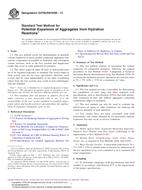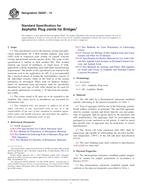Potrebujeme váš súhlas na využitie jednotlivých dát, aby sa vám okrem iného mohli ukazovať informácie týkajúce sa vašich záujmov. Súhlas udelíte kliknutím na tlačidlo „OK“.
ASTM C1760-12
Standard Test Method for Bulk Electrical Conductivity of Hardened Concrete (Withdrawn 2021)
Automaticky preložený názov:
Štandardná skúšobná metóda pre objemovou elektrickou vodivosťou zatvrdnutého betónu
NORMA vydaná dňa 1.1.2012
Informácie o norme:
Označenie normy: ASTM C1760-12
Poznámka: NEPLATNÁ
Dátum vydania normy: 1.1.2012
Kód tovaru: NS-12373
Počet strán: 5
Približná hmotnosť: 15 g (0.03 libier)
Krajina: Americká technická norma
Kategória: Technické normy ASTM
Kategórie - podobné normy:
Anotácia textu normy ASTM C1760-12 :
Keywords:
chloride diffusion, chloride penetration resistance, conductivity, corrosion, resistivity, ICS Number Code 91.100.30 (Concrete and concrete products)
Doplňujúce informácie
| Significance and Use | ||||||||||||||||
|
This test method measures the bulk electrical conductivity of concrete, which has a theoretical relationship to the diffusion coefficient of chloride ion, or other ions, in the concrete (1, 2). Experimental data confirm that there is a correlation between the apparent chloride diffusion coefficient measured by Test Method C1556, or similar method, and the bulk electrical conductivity (3, 4). A number of factors are known to affect electrical conductivity of concrete: water cementitious materials ratio, the type and amount of supplementary cementitious materials, presence of polymeric admixtures, admixtures that contain soluble salts, specimen age, air-void system, aggregate type, degree of consolidation, degree of saturation, and type of curing. Different curing methods are used in this test method depending on whether the concrete contains supplementary cementitious materials. Use the same method and duration of curing when comparing mixtures. This test method is suitable for evaluation of concrete mixtures for proportioning purposes and for research and development. Specimens must be sufficiently saturated for measured electrical conductivity to provide an indication of the resistance of the concrete to chloride ion penetration. Because the electrical conductivity depends upon the degree of saturation, specimens are vacuum saturated before testing to ensure a common reference state for comparison purposes. If the specimen is tested in a partially saturated, or “as delivered” state, it shall be noted in the test report. This test can be used to evaluate the electrical conductivity of concretes in structures for applications that may require such information, such as the design of cathodic protection systems. The type of specimen and conditioning procedure depends on the purpose of the test. For evaluation of concrete mixtures, specimens are 100 mm diameter molded cylinders that are moist cured up to the time of testing. For evaluation of concrete samples taken from structures, specimens are 100 mm diameter cores that are vacuum saturated before performing the test. Age of the test specimen may have significant effects on the test results, depending on the type of concrete and the curing procedure. Most concretes, if properly cured, become progressively and significantly less conductive with time. Measured electrical conductivity can be used as a basis for determining the acceptability of a concrete mixture. Note 2—Because the method and duration of curing of test specimens affect the test results, the acceptance criteria will need to specify the curing procedure and test age. |
||||||||||||||||
| 1. Scope | ||||||||||||||||
|
1.1 This test method covers the determination of the bulk electrical conductivity of saturated specimens of hardened concrete to provide a rapid indication of the concrete's resistance to the penetration of chloride ions by diffusion (See Note 1). The results of this test method can be related to the apparent chloride diffusion coefficient that is determined using Test Method C1556. Note 1—The term “bulk” is used because the electrical conductivity is determined by measuring the current passing through all the phases of a test specimen (e.g., cement paste, sand, aggregate). This is accomplished using electrodes that cover the ends of the specimen. Other test methods that measure conductivity may use probes placed on the side surface of the specimen. 1.2 Units—The values stated in SI units are to be regarded as standard. No other units of measurement are included in this standard. 1.3 This standard does not purport to address all of the safety concerns, if any, associated with its use. It is the responsibility of the user of this standard to establish appropriate safety and health practices and determine the applicability of regulatory limitations prior to use. (WarningFresh hydraulic cementitious mixtures are caustic and may cause chemical burns to exposed skin and tissue upon prolonged exposure. ) |
||||||||||||||||
| 2. Referenced Documents | ||||||||||||||||
|
Podobné normy:
Historická
1.2.2013
Historická
1.6.2010
Historická
1.6.2013
Historická
1.12.2013
Historická
1.7.2013
Historická
1.6.2006



 ASTM D4787-13
ASTM D4787-13 ASTM D4791-10
ASTM D4791-10 ASTM D4792/D4792M-13..
ASTM D4792/D4792M-13.. ASTM D5821-13
ASTM D5821-13 ASTM D6297-13
ASTM D6297-13 ASTM D6532-00(2006)..
ASTM D6532-00(2006)..
 Cookies
Cookies
